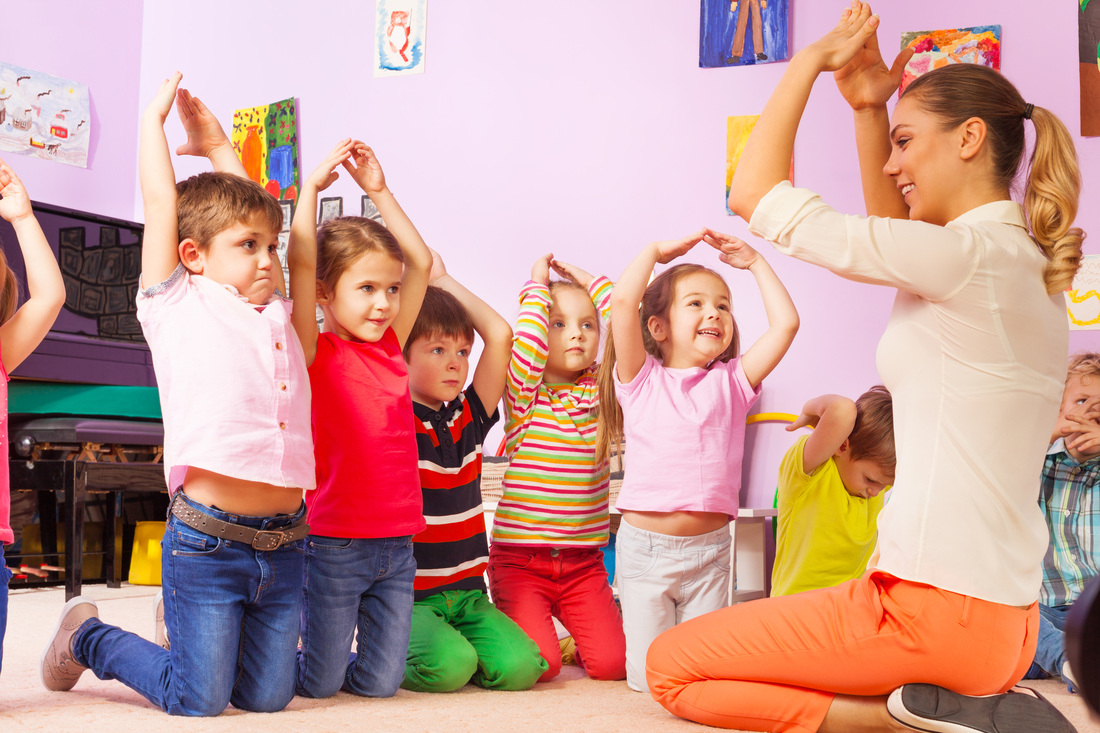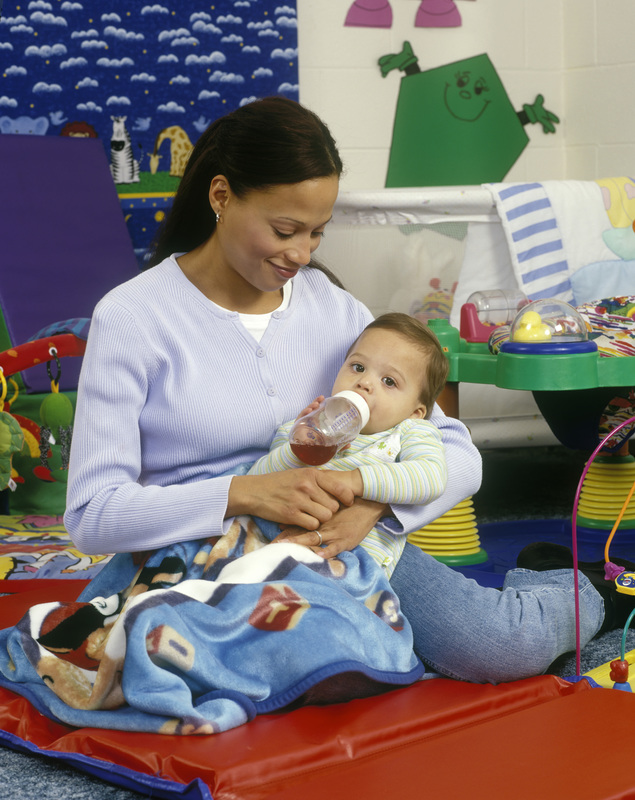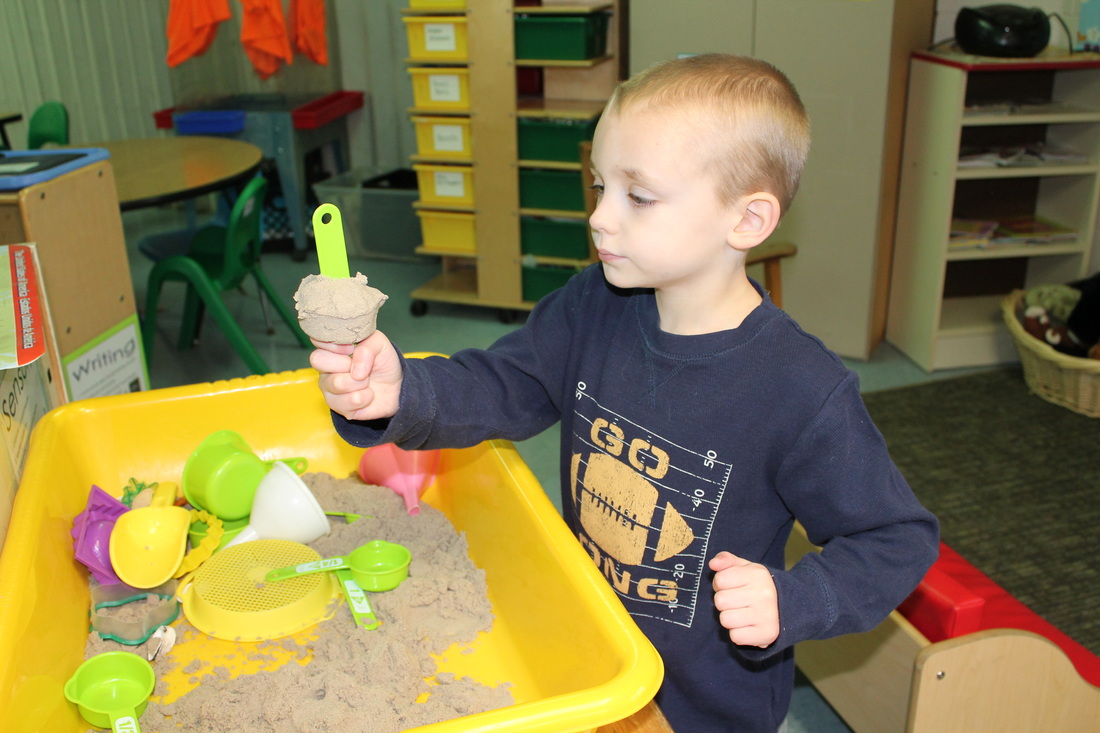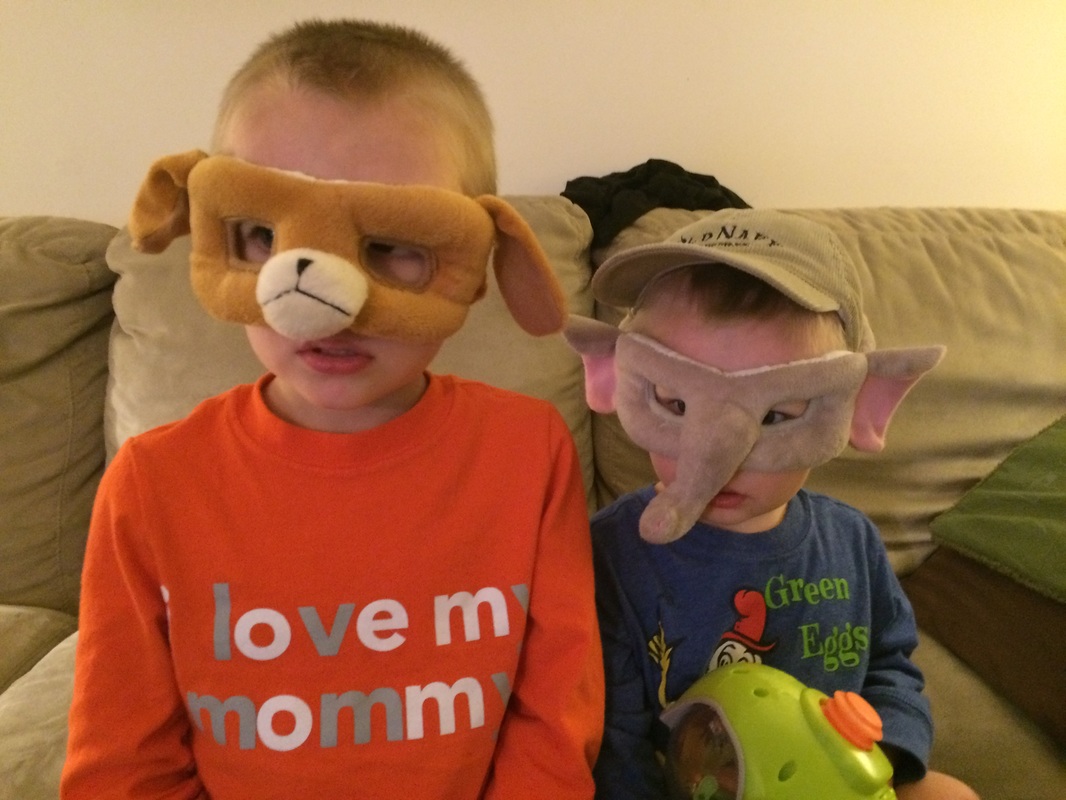|
Developmentally-Appropriate Practice (DAP) is a style of teaching where the teachers create goals for the children based on the individual developmental level of each child and then find ways to support each child to meet those individual goals. In the preschool classroom, a DAP classroom is led by the interests of the children, and the classroom allows young children to learn through play. Since children enter preschool at many different levels of development (particularly in multi-age or inclusive classrooms), the classroom must be designed to support a variety of learners. Here are some items found in the DAP preschool classroom:
There are several things that you should not see in a developmentally-appropriate classroom:
You can learn more about Developmentally-Appropriate Practice at http://www.naeyc.org/DAP.
2 Comments
Daycare is defined as the care and supervision of other people’s children. This terminology is usually associated with taking care of the basic needs of young children (ex. feeding them, changing diapers, putting them to sleep). The word daycare is often associated with poor quality care or with sympathy for young children that are separated from their family during the day. Due to a large number of children in daycares with limited staff, a daycare center could be filled with the sounds of children crying.
In the past, anyone could work in a daycare. There were previously no standardized qualifications to accept this position. This often meant that individuals who were turned down for higher paying jobs accepted a job in a daycare. Adults working in a daycare centers just needed to make sure that the children were still safe at the end of the day when their parents returned. There has now been a shift in early childhood education. Just like bankers, doctors, and lawyers, early childhood professionals must have more extensive training in a specific set of skills. Childcare is no longer solely about safety and supervision. That is only the foundation of quality early childhood education. A qualified early childhood professional must be able to demonstrate skills including:
This is a list of daily requirements that early education experts must master when they enter the field. Based on these skills, the required education, and the professionalism of qualified early childhood professionals, they do not need to be associated with “daycare.” These are teachers and early childhood experts that work in quality early childhood education programs. They deserve the same respect as other skilled professionals that work in demanding and essential fields of practice. Many parents are very interested in their children learning to write their names in preschool. This is a skill that children will need in kindergarten; however, many preschool students may not be ready yet. Preschoolers need to have muscle control in their hands and throughout their bodies in order to correctly hold a pencil and print letters. Child development principles tell us that children develop from the center of the body out towards extremities. This means that children must first develop control of their core muscles and their upper body before they will have control of their hand muscles. When a child is struggling with handwriting, many occupational therapists will recommend activities like swimming and climbing before sitting a child down with paper and pencil.
If children are strongly encouraged to practice printing before they are developmentally ready, it can cause strain to the muscles in their hands. Some children may even feel stress when the teacher invites them to participate in activities that they find to be too challenging. Preschool should be a time when teachers can help cultivate a love of learning in their students, but this love of learning can not develop if children are afraid to participate in classroom activities. A developmentally-appropriate preschool classroom focuses on allowing children to explore the classroom materials instead of asking children to sit at tables and complete teacher-directed activities. To prepare children for handwriting activities in elementary school, preschool teachers need to allow children to participate in activities where they explore the alphabet letters and improve their fine motor skills. Appropriate fine motor activities include: peg boards, play dough, modeling clay, lacing boards, puzzles, nuts and bolts, shape sorters, stringing beads on pipe cleaners, basic sewing activities, using tongs or tweezers, sorting, using small blocks or Legos, or ripping paper. In fact, play dough and modeling clay are two of the best activities that children can use at home to develop hand strength and prepare for handwriting activities. Children in preschool can begin creating letters by: writing letters in shaping cream, making letters with wood pieces, exploring alphabet puzzles, tracing on sandpaper letters, finding alphabet beads in play dough or in a sensory table, using magnetic letters on a cookie sheet, felt letters on a flannel board, drawing letters on a Magnadoodle, creating letters with play dough, labeling all materials throughout the classroom, and displaying environmental print familiar to young children. These activities can help children learn what letters look like while developing their hand strength. They also support a free-choice classroom that is led by the interests of the children and establish independence by allowing children to select their own materials and learn at their own pace. Many parents view pretend play as a recreational activity and not a learning experience. The truth is that pretend play skills have huge value. Pretend play can be defined as children acting out stories that involve the emotions and perspectives of different characters. Children use pretend play when manipulating dolls, when dressing up and pretending to be someone else, or by pretending to play with an imaginary person or character. Although these activities seem light-hearted, they have a powerful effect on multiple areas of development.
Social & Emotional Development Pretend play allows children to play cooperatively, to share with one another, and to develop empathy for another person’s situation. Young children typically see the world through their own eyes without considering the perspective of others. Pretend play opens the door for a child to consider how someone else feels and how a situation may affect more than one person. When children start to show pretend play skills they are usually alone making toys interact with one another. As they become more advanced socially they begin to interact with other children and have more intricate pretend play plots. This often leads to more advanced problem solving skills as children learn to solve a problem that another friend introduces to the pretend play scenario. Language Development It can be extremely interesting to listen to a child’s language during pretend play. As a parent, you may hear an exact replica of phrases and expressions that you regularly use. You may even be surprised at the amount of language your child is using to express himself. Pretend play encourages children to use language skills so that they can explain the actions and the stories that they are using to play. In group pretend play activities, the children must ask questions and explain themselves to peers in order to further the story. Children also learn that language has meaning to the story, which is a skill that will help with reading development. Problem-Solving Skills When children are pretending, they often have a variety of problems to solve. They could be as simple as two children wanting to be the same character in their story, or in a more elaborate story, they could have a mystery to solve and must move through stages of story development. Pretend play also creates abstract thought. Children develop pretend play stories by seeing pictures in their minds and trying to act out those pictures with their bodies. If a child is missing a prop for his story, he must find a way to adapt the materials that are available and solve the problem. All of these skills lead to higher level thinking. Physical Development During pretend play children often use both gross and fine motor skills. Pretend play often encourages children to dress and undress in imaginative outfits, so children may be learning to snap, button, tie, and zip. These are all necessary self-help skills that assist with hand-eye coordination. Also, pretend play may encourage large muscle skills as well. When a child on the playground pretends to be a firefighter and climbs to the top of the play structure to save someone from a burning building, she is also working on climbing and visual discrimination. Pretend Play at Home It may be more difficult to encourage pretend play at home since your child is not around peers. Many different types of toys encourage pretend play. Items like Little People, Legos, cars and trucks, action figures, and dress up clothing can nurture a pretend play environment. If you don’t have these toys at home, you can create a prop box that will encourage your child to make-believe. Here are some items that you may want to include:
The purpose of high-quality childcare is to ensure that children with and without special needs reach their full potential by collaborating with families, therapists, and community partners. For some children, that means providing the highest quality preschool education with educated teachers and low student-to-teacher ratios. For other children, that also involves incorporating therapists to address a development delay in one or more areas. An integrated preschool education environment allows children with and without special needs to interact and learn from one another in the same classroom.
Children with a diagnosed developmental delay will have peer models to show them how to achieve each developmental milestone. Children with typical abilities solidify their own learning through teaching their peers. This system is much like that used in our teaching hospitals today, “See It, Do It, Teach It”. A child is introduced to a skill when he sees another child demonstrate the activity. He moves to the next stage of learning when he is able to act out the skill himself. Finally, a skill is truly mastered once a child understands it well enough to explain it to a peer. This inclusive classroom design also allows children to associate with peers with a diversity of skills and abilities and learn to appreciate those differences. It is essential to make sure that all children and families are treated with the utmost respect. One of the ways that we try to achieve this goal is by using People-First Language. People-First Language means always putting the person before the disability. For example, instead of saying “a CP child”, you would say a child with Cerebral Palsy. Instead of saying “an Epileptic child”, you would say “a child with Epilepsy”. Instead of saying “a disabled child”, you would say “a child with a physical delay”. Using People First Language is not about being politically-correct. Instead, it is a sign of respect that the disability is merely one characteristic of a person that may have many feelings, attributes, and talents. The tone and characteristics of our language show our attitude and inadvertently shape our mindset. Even more concerning, our language shapes the mindset of our children who are listening to our vocabulary on a daily basis and learning to copy our every word. It is essential that we start teaching our children People-First Language now so that we eliminate this unnecessary prejudice as soon as possible. Start listening to your own speech and the speech of those around you, and challenge yourself to correct these inconsistencies. It is one small way to show additional respect to others. As a parent or a grandparent today, your memory of a parent-teacher conference may involve a time when you got in trouble in school. In past generations, teachers used parent-teacher conferences as an opportunity to tell families that their children were in trouble or their children were falling behind in school. That is no longer the case. Now, parent-teacher conferences are used as one of the main communication methods between teachers and the family! They are a vital part of a successful education program. High quality early childhood education programs, with the assistance of parent-teacher conferences, invite families to actively take part in decision-making opportunities concerning their children’s education. Programs and families collaborate in establishing goals for children’s education and learning both at home and at school.
Conference Topics Many parents often ask what will be discussed at a parent-teacher conference for a young child. Here are some of the topics that your child’s teacher may cover:
What to Ask at a Parent-Teacher Conference Although conferences may be limited in time, there are a few items that it is important to ask about when your family has individual time with the teacher. If the teacher does not cover these topics, here are a few things to ask about:
Concerns Occasionally families will be surprised by information that they receive in a conference because it does not match what they are seeing in the home environment. The major variable for children between the home and school environment is the social setting with numerous children. A child that does well when he or she has the family’s full attention at home (or even shares attention with one or two siblings) may show very different behavior when he or she must share attention with seven or more peers in the classroom setting. Parents do not need to be disheartened by this information. Teachers have a wide variety of resources that can assist your child in any area with which he or she is struggling. If a child is struggling with a mild issue, it could be as simple as the family and the classroom teachers collaborating to make sure they are addressing the situation the same in the home and the school environment. If the family has a greater concern, then the teacher can assist the family with starting the referral process with a pediatrician or local specialist for therapy support in the area of concern. The main goal is to make sure that each child is working to his or her full potential so that he or she will be as prepared as possible to enter Kindergarten. Infants and Toddlers Families frequently ask if it is still important to have a parent-teacher conference if the child is an infant or toddler. It is just as essential (if not more so) to meet with the teachers when a child is in the infant room as when the child is in preschool. The point of the conference is to share information between the teachers and the family. During an infant/toddler conference, the following information needs to be shared:
Have you ever noticed how some young children love to roll in the mud and others refuse to finger paint? Some children are terrified of loud noises like fireworks and others do not seem to be affected by them. Does your child love to receive bear hugs or does she refuse to let you touch her? All of these reactions stem from how the child takes in sensory information. Jean Piaget, a developmental theorist, believed that young children learn by exploring and taking in sensory information. You can see this in action when you watch a young toddler chew on a toy or touch everything that he can reach. We know that our five basic senses are vision, hearing, smell, taste and touch. In sensory processing, the brain takes that information and interprets it to help the body react. Research has shown us that there are three other supplementary sense systems:
Although everyone shows some of these sensory preferences, there can be a concern if a child’s sensory-seeking behaviors or sensory-defensive behaviors begin to limit his or her ability to participate in normal childhood activities. Some children may significantly struggle with loud noises, the feeling of a type of clothing, changes in routine, or someone accidently brushing up against them in the classroom. If a child’s sensory preferences does not allow him or her to participate in normal childhood activities, then it may be time to speak with your pediatrician or seek an evaluation from an occupational therapist. Occupational therapists can work with the child to keep these impulses under control so that he or she can participate in normal home and classroom activities just like other children the same age. There are many benefits when your toddler begins to dress himself. Self-dressing is a key step in the potty training process. Also, this type of achievement can have a huge impact on your child’s self-esteem and feelings of self-confidence. Undressing skills typically emerge between the ages of 13-24 months of age. Once a child learns how to undress, it is not unusual to find your child completely naked when you walk in to greet him/her in the crib each morning. These are skills that the child will want to duplicate again and again for the sake of mastery! She may be able to put on loose-fitting clothing as early as 24 months, but it may be a few additional months before she can put on something as snug fit as a t-shirt. It is essential at this stage of development to dress your child in clothing that is easy for him/her to manage independently. Two-piece outfits with elastic waistbands are the best outfits with which to learn to dress and undress. One piece outfits, overalls, and belts can make it very challenging for a child to master these new skills. Beginning at the age of three or older, a child may be able to dress and undress independently.
What is Involved in Dressing? Gross Motor Skills (Large Muscle Movements): Moving both arms and legs with coordination, Balancing on one foot while stepping in and out of clothing Fine Motor Skills (Small Muscle Movements & Hand-Eye Coordination): Finger coordination for zippers, buttons, etc. Progression of Clothing Difficulty
Cognitive Skills: Understanding sequencing (what comes first, second, etc.), What clothing is weather appropriate, and what colors match When You First Begin
Children thrive in a structured and predictable environment. Routines like drop-off and pick-up, meals, naps, and diapering/toileting need to occur at regular intervals each day and be handled the same by each caregiver. This structure can create a sense of safety and security for each young child in the classroom. Parents and childcare providers both need to understand that, even when a schedule is established, working with young children can mean that the schedule must change based on the needs of the child. This means that each classroom schedule needs to be structured yet flexible.
In order to establish daily routines, most early childhood classrooms follow a basic daily schedule. The schedule can help to ensure the consistency that young children need and also help teachers encourage all areas of development by planning a wide range of activities. It's helpful to think of a daily schedule as a guide which is responsive to children and teachers. Flexible schedules still give the classroom an opportunity to focus on moments when children discover something that interests them. When a teacher creates a beneficial schedule, it should find a balance for children, between group times and individual play, quiet and energetic play, and indoor and outdoor play. Transition times can create the difference between a calm and coherent classroom compared to a chaotic group of children running throughout the room. Well-planned transition periods are successful when teachers plan enough time for the children to transition from one activity to another and the new activity is prepared for the children. Some children require additional preparation for a transition, so it can be helpful for the teacher to offer several reminders as the transition approaches. Children are much more likely to cooperate during a transition if they have time to complete their activity first. Teachers can also make the transition process smoother by encouraging children who are doing what is asked of them and using positive language to describe the new activity. Schedules benefit young children in several different ways:
While every child learns to speak at his or her own pace, general milestones can serve as a guide to normal speech and language development. These milestones can also be a guide for parents, teachers, doctors, and therapist to identify delays as early as possible.
By the end of three months, a child might:
By the end of six months, a child might:
By the end of 12 months, a child might:
By the end of 18 months, a child might:
By the end of 24 months, a child might:
When to check with the doctor or seek an evaluation with a speech pathologist Parents should speak with the child's doctor if he or she hasn't mastered most of the speech and language development milestones for his or her age or if the family is concerned about any aspect of the child's development. The sooner a child receives early intervention services (like speech pathology), the quicker the delay can be resolved. This typically leads to shorter time periods that speech therapy is needed. Speech delays occur for many reasons, including hearing loss and developmental disorders. A speech pathologists will be able to do a full evaluation of your child’s language skills; however, many insurance companies will require a doctor referral and/or a hearing test to see if there is a medical reason behind the delayed speech. When you are with the child, take every possible opportunity to talk to him. Explain to her what you are doing and where you are going. Ask questions about his day, even if he may not understand all of the vocabulary yet. Sing songs and read together. Teach the child to imitate actions, such as clapping, and to say animal sounds. Practice counting. Show the child that you're pleased when he or she speaks. Listen the child's sounds and repeat them back to him or her. These steps can encourage speech and language development. |
AuthorDr. Sarah Vanover has been working in the field of early childhood education for over 22 years and has had the opportunity to be a teacher, a director, and a trainer for other early childhood educators. She has a passion for making sure that children with special needs receive high-quality early care and education. Archives
September 2017
Categories |




 RSS Feed
RSS Feed